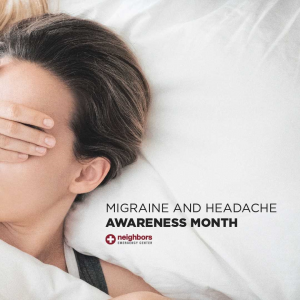
Some people know the feeling all too well. Throbbing pain and nausea, vomiting and sensitivity to light. Several symptoms can mark the beginning of a migraine. Over 38 million Americans experience migraines, each with their own unique set of triggers and side effects.
As those who experience migraines know, they can be extremely debilitating and painful. June is Migraine Awareness Month. Neighbors Emergency Center encourages you to share this article and spreading awareness. Here are five important migraine questions to help you understand more.
When Do Migraines Begin?
For most people, migraine headaches begin between the ages 10 and 40. Although they do occur in men, they are three times more common in women. Most women report their migraines improve or even disappear by age 50.
What Causes Migraines?
Migraines are caused by brain cells that are overly sensitive to certain triggers. Several factors can set off these triggers such as intense emotion, foods and even certain smells and sounds. These triggers cause the brain to release chemicals that cause inflammation and pain.
What are Common Migraine Triggers?
Weather changes- This is one of the most difficult migraine triggers to control as changes in humidity, temperature and air pressure can be problematic.
Anxiety and stress- Migraines commonly occur during periods of anxiety and stress for many people. If you can reduce your stress and relax, the migraine can subside.
Wine and aged cheeses- Both alcohol and cheese contain a compound called tyramine that is known to trigger migraines.
Perfumes and scents- Perfume can cause a sudden and adverse reaction – especially if the scent is strong.
Medication- Several types of medication can cause migraines and the most common is birth control pills or estrogen-related treatment.
Monosodium glutamate- Commonly known as MSG, foods prepared with this should be avoided. This includes seasonings, frozen foods, processed meat, premade soups and condiments.
Nitrates- This can be found most commonly in deli meats like pepperoni, salami, hot dogs and lunch meats.
Hunger and Caffeine- The body’s needs are extremely sensitive and missing a meal or experiencing caffeine withdrawal can be a migraine trigger.
Many women find their migraine symptoms are heightened before their menstrual cycle, leading doctors to believe a lack of estrogen may also cause migraines.
What are the most common types of migraines?
Aura
About 25% of those who suffer have migraines with aura and are plagued by these painful but not life-threatening attacks.
Auras tend to start about an hour before the headache and have the ability to affect your senses. They can cause blind spots, vision loss and cause you to see flashing lights or zigzag patterns. You may also see and smell things that are not there and experience tingling or numbness. These symptoms are brief, normally fading as the headache phase emerges. Migraine pain with aura includes steady throbbing that is usually located in the front or side of the head. These headaches can last from one hour to three days. Additional symptoms include upset stomach, vomiting, hot flashes and chills, runny nose, dizziness, sore neck and confusion.
Scientists are not exactly sure what causes this specific type of migraine but it is believed that nerve cell activity spreads throughout the brain, causing the trigeminal nerve to release a variety of neurotransmitters. This then causes a change in the size of blood vessels leading to inflammation and pain.
Without Aura
Migraines without Aura are the most common and account for about 75% of all migraines. The most common symptom is a throbbing headache that generally worsens with time. You may also experience nausea and vomiting, sensitivity to light, noise, and smell, blurred vision and stiffness of the neck and shoulders. These migraines can last from 4-72 hours.
Scientists are not fully aware of what causes these migraines. They believe two key brain chemicals play a role: serotonin and dopamine. It is suggested that something in the brain goes awry, causing an upset in the way these chemicals regulate the brain. In response, the brain and the body’s immune system overreact causing a flood of immune cells to flow through the blood vessels and into the brain. The result is a severe, throbbing headache.
How do I treat migraines?
When you experience migraines try and find a quiet, dark room. Pain relievers like ibuprofen or aspirin may help lessen your symptoms. You can also use a cold compress on areas of your head that are experiencing pressure and pain. If your symptoms persist, speak with your doctor about prescribing other medicines that may help with nausea or vomiting. Most importantly, avoid your triggers. If you are aware of what causes your migraines, steer clear. If you don’t know your triggers keep a headache diary, so that you can identify what is causing them.
If you are experiencing migraine symptoms, see your doctor for a physical exam. They can check your muscles, speech, reflexes and symptoms to test the nerves in your head. Blood tests, CT scans, X-rays and MRIs can also be used to rule out other causes of concern such as infection and bleeding. If you do find yourself in need of emergency services, remember there are 22 Neighbors Emergency Center locations throughout Texas to help you. Our board-certified physicians and state-of-the-art technology make it easy for us to care for you or your family’s medical emergencies.

